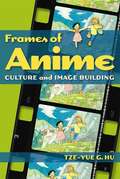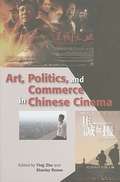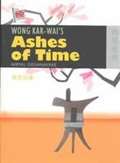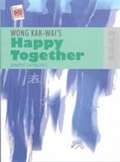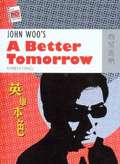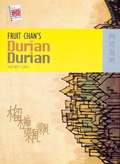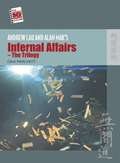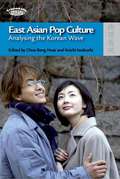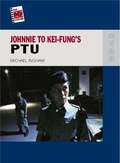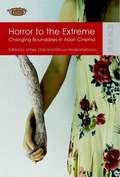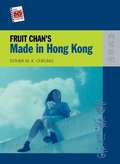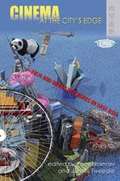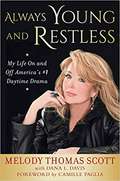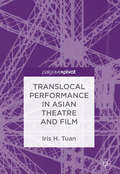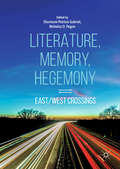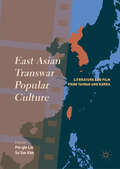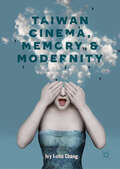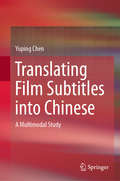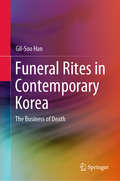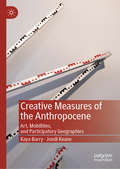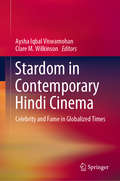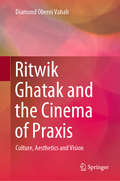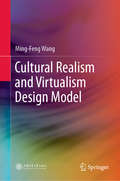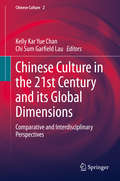- Table View
- List View
Frames of Anime
by Tze-yue G. Huapanese anime has long fascinated the world, and its mythical heroes and dazzling colors increasingly influence popular culture genres in the West. Tze-yue G. Hu analyzes the 'language-medium' of this remarkable expressive platform and its many socio-cultural dimensions from a distinctly Asian frame of reference, tracing its layers of concentric radiation from Japan throughout Asia. Her work, rooted in archival investigations, interviews with animators and producers in Japan as well as other Asian animation studios, and interdisciplinary research in linguistics and performance theory, shows how dialectical aspects of anime are linked to Japan's unique experience of modernity and its cultural associations in Asia, including its reliance on low-wage outsourcing. Her study also provides English readers with insights on numerous Japanese secondary sources, as well as a number of original illustrations offered by animators and producers she interviewed.
Art, Politics, and Commerce in Chinese Cinema
by Ying ZhuArt, politics and commerce are intertwined everywhere, but in China the interplay is explicit, intimate and elemental, and nowhere more so than in the film industry. Understanding this interplay in the era of market reform and globalization is essential t
Wong Kar-wai's Ashes of Time
by Wimal Dissanayake'Ashes of Time,' by the internationally acclaimed director Wong Kar-wai, has been considered to be one of the most complex and self-reflexive of Hong Kong films. Loosely based on the stories by renowned martial arts novelist Jin Yong, Wong Kar-wai has created a very different kind of martial arts film, which invites close and sustained study.This book presents the nature and significance of Ashes of Time, and the reasons for its being regarded as a landmark in Hong Kong cinema. Placing the film in historical and cultural context, Dissanayake discusses its vision, imagery, visual style, and narrative structure. In particular, he focuses on the themes of mourning, confession, fantasy, and kung fu movies, which enable the reader to gain a deeper and more comprehensive understanding of the film.
Wong Kar-wai's Happy Together
by Jeremy TamblingWong Kar-wai's controversial film, 'Happy Together,' was released in Hong Kong just before the handover of power in 1997. The film shows two Chinese gay men in Buenos Aires and reflects on Hong Kong's past and future by probing masculinity, aggression, identity, and homosexuality. It also gives a reading of Latin America, perhaps as an allegory of Hong Kong as another post-colonial society. Examining one single, memorable, and beautiful film, but placing it in the context of other films by Wong Kar-wai and other Hong Kong directors, this book illustrates the depth, as well as the spectacle and action, that characterizes Hong Kong cinema. Tambling investigates the possibility of seeing Happy Together in terms of 'national allegory', as Fredric Jameson suggests Third World texts should be seen. Alternatively, he emphasizes the fragmentary nature of the film by discussing both its images and its narrative in the light of Borges and Manuel Puig. He also looks at the film's relation to the American road movie and to the history of the tango. He poses questions how emotions are presented in the film (is this a 'nostalgia film'?); whether the masculinity in it should be seen negatively or as signs of a new hopefulness about Hong Kong's future; and whether the film indicates new ways of thinking of gender relationships or sexuality.
John Woo's A Better Tomorrow
by Karen Fang'A Better Tomorrow' has always been hailed as a milestone in Hong Kong cinema. This book describes the different responses to the movie in Hong Kong and later in its reception worldwide, which paved the way for the promotion of John Woo and Chow Yun-fat to their current prominence in Hollywood. Fang examines the different notions of the genre of action cinema in Asian and Western film industries. She tracks the connections between ying shung pian, or "hero" movie, the term by which Woo's film became famous in Hong Kong, and the spectacle of violence emphasized in the term "heroic bloodshed," the category in which the film was known in the West. Finally, she concludes with a discussion of the status of the film and its huge success in the current globalized industry.
Fruit Chan's Durian Durian
by Wendy GanThis book examines how Fruit Chan's Durian Durian sensitively portrays the unsettling seismic shifts affecting the inhabitants of both China and Hong Kong in a post-1997 context. The study covers different aspects of Durian Durian: its relation to the Hong Kong independent film sector and traditions of Hong Kong social realism; its representations of mainland Chinese women; and its representations of cross-border relations and issues of post-1997 identity for both inhabitants of Hong Kong and China. Gan argues that Durian Durian is an attempt to re-think Hong Kong and China as a single entity, a single imagined community in a post-1997 era. The film is an exploration of 'one country, two systems' not just in political but in spatial and affective terms. This is one of the first studies of Fruit Chan's work and presents him as one of Hong Kong's key filmmakers, worthy of serious critical study. Durian Durian is one of Chan's masterpieces and its study is of interest to anyone who is concerned with post-1997 realities in Hong Kong and China as visualized on film.
Andrew Lau and Alan Mak's Infernal Affairs - The Trilogy
by Gina MarchettiInfernal Affairs has received journalistic, popular and corporate notice but little vigorous critical attention. In this book, Gina Marchetti explores the way this example of Hong Kong's cinematic eclecticism have crossed borders as a story, a commercial product and a work of art; and has had an undeniable impact on current Hong Kong cinema. Moreover she uses this film to highlight the way Hong Kong cinema continues to be inextricably intertwined with global film culture and the transnational movie market.
East Asian Pop Culture
by Chua Beng HuatThe International group of contributors of this volume provides, collectively, a multi-layered analysis of the emerging East Asian media culture, using the Korean TV drama as its analytic vehicle. By closely examining the political economy of TV industry, audiences of the regional media flows in terms of gender subjectivity constructions, perceptions of colonial-postcolonial relationships, and nationalist responses to trans-national media culture exchanges, this volume highlights the multiple connectivities and implications of popular cultural flows and exchanges in East Asia.
Johnnie To Kei-Fung's PTU
by Michael InghamPTU is an underappreciated noir masterpiece by one of Hong Kong's most prolific and commercially successful directors. Johnnie To Kei-fung has been called "the poet of post-1997 and the economic savior of the Hong Kong film industry" for an extraordinary range of films produced during some of Hong Kong cinema's most difficult years. While many of To's celebrated films such as Election, Exiled and The Mission feature themes of criminal glory and revenge, PTU centers on the ethical dilemmas, personal dramas and stoic teamwork in the elite Police Tactical Unit. The story follows the PTU's all-night search for an officer's missing gun as they navigate triad turf struggles and marauding jewel thieves from mainland China. Shot over several years in the hauntingly empty pre-dawn streets of Tsim Sha Tsui, and released coincidentally amid the 2003 SARS panic, the film evokes Hong Kong's post-handover economic despair and multiple identity crises. In terms of character development and psychological complexity, Mike Ingham argues that PTU is the most aesthetically rigorous and satisfying of To's many films.
Horror to the Extreme
by Jinhee Choi Mitsuyo Wada-MarcianoThis book compares production and consumption of Asian horror cinemas in different national contexts and their multidirectional dialogues with Hollywood and neighboring Asian cultures. Individual essays highlight common themes including technology, digital media, adolescent audience sensibilities, transnational co-productions, pan-Asian marketing techniques, and variations on good vs. evil evident in many Asian horror films. Contributors include Kevin Heffernan, Adam Knee, Chi-Yun Shin, Chika Kinoshita, Robert Cagle, Emilie Yeh Yueh-yu, Neda Ng Hei-tung, Hyun-suk Seo, Kyung Hyun Kim, and Robert Hyland.
Fruit Chan's Made in Hong Kong
by Esther M. K. CheungThis tragic coming-of-age story follows three disillusioned local youths struggling to navigate Hong Kong public housing projects and late adolescence amid violent crime, gang pressure, and broken homes. Their personal friendships and family lives intersect with a mysterious fourth protagonist, a girl whose suicide haunts the other three throughout the film as they move toward their own premature ends. This 1997 film was the first in Chan's acclaimed "handover trilogy." Shot on a very low budget, utilizing excess film stock, amateur actors, and a crew of five, it marked the beginning of Chan's career as an independent film director.
Cinema at the City's Edge
by Yomi BraesterThis anthology includes a number of leading voices on contemporary Asian cinema studies, including Ackbar Abbas, Chris Berry, Emilie Yueh-yu Yeh, Darrell William Davis, Dudley Andrew, Yomi Braester, Susie Jie Young Kim, Akira Mizuta Lippit, James Tweedie
La coartada perpetua
by Ambrosio FornetUna de las figuras más destacadas de la crítica literaria y cinematográfica cubana reúne en este libro sus mejores ensayos. Preocupado por los problemas que relacionan la historia moderna de Cuba con sus intelectuales, Ambrosio Fornet ha desplegado en sus textos un talento excepcional para definir las líneas del peculiar desarrollo de la cultura cubana a partir de la guerra hispano-cubano-americana de 1898 y de la independencia mediatizada, a la que dio lugar después de tres años de ocupación norteamericana. Tal es el asunto del primero y cuarto ensayos de esta colección. La revolución de 1959 que rompió este proceso neocolonial, inició una ambiciosa experiencia socialista que encontró hasta hoy, en Estados Unidos, un enemigo decidido a destruirla. ¿Cómo esa revolución ha podido, durante más de cuarenta años, resistir ese amenazador enfrentamiento sin abandonar sus propósitos de liberación y justicia social? El segundo ensayo de este libro brinda el "testimonio personal" de Ambrosio Fornet que responde a ese "enigma cubano". El exilio que las medidas revolucionarias cubanas provocaron desde muy pronto y que Estados Unidos propició de manera constante, determinaron la aparición en Estados Unidos de una literatura cubana del exilio que se ha manifestado y se manifiesta tanto en español como en inglés. Los méritos de esta creación literaria exiliada y los conflictos provocados por el bilingüismo han sido un tema en el que Fornet se ha explayado con notable objetividad y brillantez según puede verse en el tercero y sexto ensayos de la colección. El más extenso de todos ellos es una interesantísima "arqueología del nuevo cine latinoamericano (1959-1979)" que hace un balance crítico importante de esa crucial etapa del cine en nuestro subcontinente. Por ultimo, el libro se cierra con un ensayo medular sobre el "testimonio" en cuanto género literario peculiar de América Latina.
Always Young and Restless: My Life On and Off Daytime's #1 Drama
by Melody Thomas ScottMelody Thomas Scott admits she is nothing like her Young and the Restless role, who has seen it all in her forty-year tenure on America’s highest-rated daytime serial. But the high drama, angst, and catastrophes aren’t confined to her character’s plotlines. In this captivating memoir, Melody reveals behind-the-scenes tales of her own riveting journey to stardom. <P><P> As Nikki went from impoverished stripper to resourceful, vivacious heroine―with missteps as gripping as her triumphs―Melody became a household name, enthralling global audiences. Her road to stardom was also her road to personal freedom, marked by an escape fit for cinema. In Always Young and Restless, Melody tells of her troubled, untraditional upbringing for the first time. <P><P> Learn how she suffered at home with her grandmother, a compulsive hoarder, whose cruelty as her guardian is shockingly extreme, and endured abuse at the hands of industry men; what it was like to act in feature films with Alfred Hitchcock, John Wayne, and Clint Eastwood; and how she took control of her life and career in a daring getaway move. And of course, Melody divulges juicy on-and-off-set details of what it’s like to be one half of the show’s most successful supercouple, “Niktor.” In witty, warm prose, meet the shining, persevering heart of an American icon―and prepare to be moved by a life story fit for a soap opera star.
Translocal Performance in Asian Theatre and Film
by Iris H. TuanThis pivot offers an innovative, trans-local perspective on performance studies in the era of digital technology, considering a range of content from theater to opera, film, dance, and musical theatre. It examines theatre performing arts and film in terms of aesthetics, gender studies, and identity politics, and showcases the value of human accomplishments in theatre and film and their representative artistic works. It also addresses key issues within performance studies, such as gender, class, race, ethnicity, identity, and how minorities portray their ethnicity stories. This book links the trans-national and the trans-local and considers how emerging mobile geographies and new methodologies of interpreting performance in theatre and film reflect the transformations of our understanding of geopolitical time and space.
Literature, Memory, Hegemony: East/West Crossings
by Sharmani Patricia Gabriel Nicholas O. PaganThis edited book considers the need for the continued dismantling of conceptual and cultural hegemonies of ‘East’ and ‘West’ in the humanities and social sciences. Cutting across a wide range of literature, film and art from different contexts and ages, this collection seeks out the interpenetrating dynamic between both terms. Highlighting the inherent instability of East and West as oppositional categories, it focuses on the ‘crossings’ between East and West and this nexus as a highly-charged arena of encounter and collision. Drawing from varied literary contexts ranging from Victorian literature to Chinese literature and modern European literature, the book covers a diverse range of subject matter, including material drawn from psychoanalytic and postcolonial theory and studies related to race, religion, diaspora, and gender, and investigates topical social and political issues —including terrorism, nationalism, citizenship, the refugee crisis, xenophobia and otherness. Offering a framework to consider the salient questions of cultural, ideological and geographical change in our societies, this book is a key read for those working within world literary studies.
East Asian Transwar Popular Culture: Literature and Film from Taiwan and Korea
by Pei-Yin Lin Su Yun KimThis collection examines literature and film studies from the late colonial and early postcolonial periods in Taiwan and Korea, and highlights the similarities and differences of Taiwanese and Korean popular culture by focusing on the representation of gender, genre, state regulation, and spectatorship. Calling for the “de-colonializing” and “de–Cold Warring” of the two ex-colonies and anticommunist allies, the book places Taiwan and Korea side by side in a “trans-war” frame. Considering Taiwan–Korea relations along a new trans-war axis, the book focuses on the continuities between the late colonial period’s Asia-Pacific War and the consequent Korean War and the ongoing conflict between the two sides of the Taiwan Strait, facilitated by Cold War power struggles. The collection also invites a meaningful transcolonial reconsideration of East Asian cultural and literary flows, beyond the conventional colonizer/colonized dichotomy and ideological antagonism.
Taiwan Cinema, Memory, and Modernity
by Ivy I-chu ChangThis book investigates the aesthetics and politics of Post/Taiwan-New-Cinema by examining fifteen movies by six directors and frequent award winners in international film festivals. The book considers the works of such prominent directors as Edward Yang, Tsai Ming-liang and Chang Tsuo-chi and their influence on Asian films, as well as emergent phenomenal directors such as Wei Te-sheng, Zero Chou, and Chung Mong-hong. It also explores the possibility of transnational and trans-local social sphere in the interstices of layered colonial legacies, nation-state domination, and global capitalism. Considering Taiwan cinema in the wake of globalization, it analyses how these films represent the socio-political transition among multiple colonial legacies, global capitalism, and the changing cross-strait relation between Taiwan and the Mainland China. The book discusses how these films represent nomadic urban middle class, displaced transnational migrant workers, roaming children and young gangsters, and explores how the continuity/disjuncture of globalization has not only carved into historical and personal memories and individual bodies, but also influenced the transnational production modes and marketing strategies of cinema.
Translating Film Subtitles into Chinese: A Multimodal Study
by Yuping ChenThis book examines three metafunction meanings in subtitle translation with three research foci, i.e., the main types of cross-modal interrelation, the primary function of semiotic interplay, and the key linguistic components influencing the subtitles. It goes beyond traditional textual analysis in translation studies; approaches subtitle translation from a multimodality standpoint; and breaks through the linguistic restraints on subtitling research by underscoring the role of semiotic interplay. In the field of multimodality, this book bridges subtitling and multimodality by investigating the interweaving relationships between different semiotic modes, and their corresponding impacts on subtitle translation.
Funeral Rites in Contemporary Korea: The Business of Death
by Gil-Soo HanThis book explores 21st century Korean society on the basis of its dramatically transforming and rapidly expanding commercial funeral industry. With insights into contemporary Confucianism, shamanism and filial piety, as well as modernisation, urbanisation, the division of labour and the digitalisation of consumption, it is the first study of its kind to offer a sophisticated, integrated sociological analysis of how the commodification of death intersects with capitalism, popular culture and everyday life in contemporary Korea. Through innovative analyses of funeral advertising and journalism, screen and literary representations of funerals, online media, consumer accounts of using funeral services and other sources, it offers a complex picture of the widespread effects of economic development, urbanisation and modernisation in South Korean society over the past quarter century. In the aftermath of the Korean “economic miracle” novel ways of paying respect to deceased kin have emerged; using Max Weber's concept of “pariah capitalism”, Gil-Soo Han shows how the heightened obsession with and boom in the commodification of death in Korea reflects radical transformations in both capital and culture.
Creative Measures of the Anthropocene: Art, Mobilities, and Participatory Geographies
by Kaya Barry Jondi KeaneThis book proposes that creative and participatory modes of measuring, knowing, and moving in the world are needed for coming to grips with the Anthropocene epoch. It interrogates how creative, affective and experiential encounters that traverse the local and the global, as well as the mundane and the everyday, can offer new perspectives on the challenges that lay ahead. This book considers the role of the arts in exploring geographical concerns and increasing human mobility. In doing so, it offers ways to counteract the unstable, shifting and disorienting impacts and debates surrounding human activity and the Anthropocene. The authors bring together perspectives from mobilities, creative arts, cultural geography, philosophy and humanities in an innovative exploration of how creative forms of measurement can assist in reconfiguring individual and collective action.
Stardom in Contemporary Hindi Cinema: Celebrity and Fame in Globalized Times
by Aysha Iqbal Viswamohan Clare M. WilkinsonIn this book, film scholars, anthropologists, and critics discuss star-making in the contemporary Hindi-language film industry in India, also known as “Bollywood.” Drawing on theories of stardom, globalization, transnationalism, gender, and new media studies, the chapters explore contemporary Hindi film celebrity. With the rise of social media and India’s increased engagement in the global economy, Hindi film stars are forging their identities not just through their on-screen images and magazine and advertising appearances, but also through an array of media platforms, product endorsements, setting fashion trends, and involvement in social causes. Focusing on some of the best-known Indian stars since the late 1990s, the book discusses the multiplying avenues for forging a star identity, the strategies industry outsiders adopt to become stars, and the contradictions and conflicts that such star-making produces. It addresses questions such as: What traits of contemporary stars have contributed most to longevity and success in the industry? How has filmmaking technology and practice altered the nature of stardom? How has the manufacture of celebrity altered with the recent appearance of commodity culture in India and the rise of a hyper-connected global economy? By doing so, it describes a distinct moment in India and in the world in which stars and stardom are drawn more closely than ever into the vital events of global culture. Hindi films and their stars are part of the national and global entertainment circuits that are bigger and more competitive than ever. As such, this is a timely book creates opportunities for examining stardom in other industries and provides fruitful cross-cultural perspectives on star identities today."Grounded in rigorous scholarship as well as a palpable love of Hindi cinema, this collection of 19 essays on a dizzying array of contemporary Hindi film stars makes for an informative, thought-provoking, illuminating, and most of all, a joyful read. Pushing boundaries of not only global Star Studies but also film theory as a whole, this de-colonised and de-colonising volume is a must read for film scholars, students and cinephiles!" Dr. Sunny Singh, Senior Lecturer - Creative Writing and English Literature, Sir John Cass School of Art, Architecture & Design, London Metropolitan University “A wide-ranging overview of Hindi cinema’s filmi firmament today, focussing on its most intriguing and brightest-burning stars. The variety of approaches to stardom and celebrity by both established and upcoming scholars reveals a web of interconnecting stories and concerns that provide fascinating new insights into the workings of today's Hindi film industry, while shining fresh light on contemporary India and the world we live in.” Professor Rosie Thomas, Centre for Research and Education in Arts and Media (CREAM), College of Design, Creative and Digital Industries, University of Westminster
Ritwik Ghatak and the Cinema of Praxis: Culture, Aesthetics and Vision
by Diamond Oberoi VahaliIn a significant departure from other works on Ritwik Ghatak, this book establishes him as an auteur and a maestro on par with some of the great film directors, like Sergei Eisenstein, Satyajit Ray, Ingmar Bergman, Federico Fellini, Kenji Mizoguchi and Luis Bunuel. Based on in-depth research that follows Ghatak’s journey within the context of the Indian People’s Theatre Association, it fills an important gap in the scholarship around Ghatak by offering crucial insights into Ghatak’s unique vision of cinema embedded as it is in the cultural psychic configurations of the people. It analyses Ghatak’s practice by minutely tracing formal similarities across the language of his cinematic oeuvre in the domain of cinematography, lighting, music, and sound. The book develops the way in which cinematic technique enters the domain of conceptual constructs and abstractions. It moves on to chronicle Ghatak’s political odyssey as reflected in his cinema. Moreover, it charts the manner in which Ghatak, through his cinematic idiom, offers a polemic of cinema that further adds to his notion of praxis – a thoughtful Marxist paradigm organically associated with the culture and context of India. By locating Ghatak within the discourse of nationalism, the book brings to the surface Ghatak’s critical insights related to the independence of the nation and the trauma of the partition of Bengal. Ghatak’s cinema served the crucial function of chronicling the mass tragedy of partition and its impact on the human psyche.This book appeals to scholars of film studies and filmmaking as well as to researchers and general readers interested in debates pertaining to culture, politics, art, psychoanalysis, partition and refugee studies, cinema, theatre, and ideology.
Cultural Realism and Virtualism Design Model
by Ming-Feng WangThe book proposes a new Cultural Realism and Virtualism design model for cultural and creative products based on Laozi’s philosophy and analysis of symbolism, metaphysics, three-layered culture, reverse-triangular cultural space and Zen aesthetics. It studies peoples that speak Austronesian languages and offers a detailed comparison of their homogeneous and heterogeneous cultures of color, clothing, housing, boats, birds, symbols, dance and ancestry, and provides insights into the cultural features of deconstruction and construction of color, style, form, shape and function, to compose cultural and creative products using complex, variable, fuzzy evaluation; and structural variation and color evaluation methods. It then uses case studies to show that the products created with the new model not only fulfilled their purpose, but also successfully entered the markets. This book helps qualify decision-making processes, improve accuracy of design scheme evaluation and enhance efficiency in product development, and as such appeals to those in the cultural and creative industry, researchers, designers and those who are interested in product design.
Chinese Culture in the 21st Century and its Global Dimensions: Comparative and Interdisciplinary Perspectives (Chinese Culture #2)
by Kelly Kar Yue Chan Chi Sum Garfield LauThis book investigates the internationalization of Chinese culture in recent decades and the global dimensions of Chinese culture from comparative and interdisciplinary perspectives. It covers a variety of topics concerning the contemporary significance of Chinese culture in its philosophical, literary and artistic manifestations, including literature, film, performing arts, creative media, linguistics, translations and philosophical ideas. The book explores the reception of Chinese culture in different geographic locations and how the global reception of Chinese culture contrasts with the local Chinese community. The chapters collectively cover gender studies and patriarchal domination in Chinese literature in comparison to the world literature, explorations on translation of Chinese culture in the West, Chinese studies as an academic discipline in the West, and Chinese and Hong Kong films and performances in the global context. The book is an excellent resource for both scholars and students interested in the development of Chinese culture on the global stage in the 21st Century.
